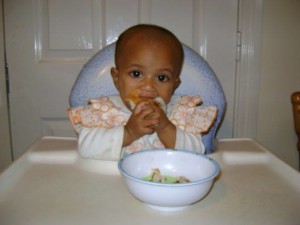
Earlier on I wrote about breastfeeding and how it was important beyond the initial six months recommended by WHO. As babies, we are completely dependant on our parents to feed us and do everything for us. As we grow, we are getting independent in different ways and want to show it too.
Baby led weaning is all about letting babies be independent and let the children feed themselves right from the beginning.
I can hear people asking “Are you crazy?”, “What do children know about food or feeding?”, “They are babies and we should feed them”, “That is just you being lazy and not wanting to spend time on feeding the baby”, “How will the baby know how much to eat?”, “The baby will never eat enough and will not put on weight!”, etc…
Before going into answering all those questions and comments let us see more about baby led weaning.
The WHO says exclusive breastfeeding till six months. Which means not even water is required. So the babies do nothing but feed off their mothers for the first six months. Six months is not a magic word, as it takes six months for the babies to get ready to start with solids. In the mean time, they are learning to see, pick, hold and put things in their mouth. Also during this period, they gain head and neck control, lose their tongue thrust and get ready to snatch food from the parent’s hands.
How will I know if my baby is ready for foods other than milk (Breast milk / Formula)?”
If your answers to the following questions is “Yes” then your baby is ready.
- Is your baby able to sit without support?
- Has your baby lost tongue thrust (Doesn’t push food out of the mouth automatically?)
- Is at least six months old
- Shows interest in food
OK, now that the baby is ready, the next question is what should I do? How do I go about baby led weaning? What can I give the baby to eat and what should I not give? Let us see the answers here:
- Do not feed the baby in lying down position, always offer the baby food when the baby is sitting down. As in a lying down position the baby can choke.
- Let the baby sit down with you at meal times and offer the same food that you eat minus sugar, salt, chili and honey.
- No mashed up or pureed food.
- Let the baby feed himself or herself
- Let the baby decide how much to eat – Trust the baby to know when they are full. Don’t force the baby to eat an extra spoon.
- Till the baby is one, milk still forms a major part of the baby’s diet – so feed the baby milk (breast of formula) first before offering food.
- If the baby doesn’t eat certain food, it is ok. Take it away and offer the food again after a few days.
- No cerelac and no dal ka pani please!
- Experiment with fruits and vegetables.
- No biscuits and no fruit juices either.
- Babies do not need gripe water.
- Breastfed babies do not need too much water after food.
- Formula fed babies need maybe 40 ml of water in 24 hours.
- Before babies master the pincer grip, give them food that they can hold.
- Most importantly, don’t take it personally – If your baby is not eating, it has nothing to do with you.
Be patient. Just like we all need practice to master an art, babies need time and practice too. Resist your temptation to feed them. Once the baby loses interest in the food in front of them, take the food away.
Food at the beginning will only be to play and experiment with. Of course, some food does go in and get tasted too. Slowly they learn to copy us and eat food the way we do.
Be prepared to clean up the mess that will be created after each meal! Slowly they learn to do it without too much of a mess.
Make the baby sit on the parent’s lap/high chair/booster seat.
BLW makes the baby eat at their own pace. If the food they put in their mouth is too much, they spit it out. When adults feed them, they have no control of what and how much goes in. Babies also learn when to stop when they are full. Avoids overeating and obesity issues later on in life.
Babies do not need teeth for us to start baby led weaning. We can offer them soft foods like steamed fruits and vegetables, soft chappathis, idlis, dosas, etc.
Here are what I think of the advantages of baby led weaning are:
- The family sits together for the meal – no story of one person feeds the baby while the others eat.
- No special baby food and purees, the baby eats the healthy meal that the parents eat too (of course sans the salt, sugar and chili)
- Baby has absolute control of what goes in, so no overeating / obesity problems later on in life too.
- Improvement in hand to eye co-ordination.
- In the long term you are respecting the baby’s independence and boosting their confidence to do things by themselves.
- No puree also means they learn to chew much earlier on.
For baby led weaning support you can join the group in Facebook: https://www.facebook.com/groups/blwindia/
If you are looking for baby friendly recipes, this group might be of help to you: https://www.facebook.com/groups/642346619243842/








